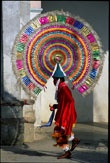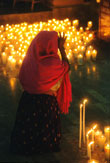|
|
|
|
|
|
|
|
|
|
|
|
|
|
|
|
|
|
|

|
Current Exhibitions Future Exhibitions Back to Exhibitions  George O. Jackson, Jr. (American, b. 1941). Un Quetzal 1997 Fiesta de Santiago Apostol, printed 2005. Inkjet print, 20 x 30 inches. Photo courtesy of the artist.
George O. Jackson, Jr. (American, b. 1941). Un Quetzal 1997 Fiesta de Santiago Apostol, printed 2005. Inkjet print, 20 x 30 inches. Photo courtesy of the artist.
 George O. Jackson, Jr. (American, b. 1941). Niños Carnavaleros 1994 Carnaval, printed 2005. Inkjet print, 20 x 30 inches. Photo courtesy of the artist.
George O. Jackson, Jr. (American, b. 1941). Niños Carnavaleros 1994 Carnaval, printed 2005. Inkjet print, 20 x 30 inches. Photo courtesy of the artist.
 George O. Jackson, Jr. (American, b. 1941). Bailando Antes de la Iglesia, 1994, Fiesta de San Juan, printed 2005. Inkjet print, 20 x 30 inches. Photo courtesy of the artist.
George O. Jackson, Jr. (American, b. 1941). Bailando Antes de la Iglesia, 1994, Fiesta de San Juan, printed 2005. Inkjet print, 20 x 30 inches. Photo courtesy of the artist.
 George O. Jackson, Jr. (American, b. 1941). El Tigre de San Fernando, 2001, Fiesta de Carnaval, printed 2005. Inkjet print, 20 x 30 inches. Photo courtesy of the artist.
George O. Jackson, Jr. (American, b. 1941). El Tigre de San Fernando, 2001, Fiesta de Carnaval, printed 2005. Inkjet print, 20 x 30 inches. Photo courtesy of the artist.
 George O. Jackson, Jr. (American, b. 1941). Cuaresma, 2000,
Cuaresma, printed 2005. Inkjet print, 20 x 30 inches. Photo courtesy of the artist.
George O. Jackson, Jr. (American, b. 1941). Cuaresma, 2000,
Cuaresma, printed 2005. Inkjet print, 20 x 30 inches. Photo courtesy of the artist.
 George O. Jackson, Jr. (American, b. 1941). La Danza de los Bixanos (Fiesta de la Virgen del Rosario. Yalalag, Oaxaca. Zapotecos/Yalaltecos), 1996. Inkjet print on archival Hannemuhle Photo Rag “Satin” 310 GSM paper, 20 x 30 inches. Photo courtesy of the artist.
George O. Jackson, Jr. (American, b. 1941). La Danza de los Bixanos (Fiesta de la Virgen del Rosario. Yalalag, Oaxaca. Zapotecos/Yalaltecos), 1996. Inkjet print on archival Hannemuhle Photo Rag “Satin” 310 GSM paper, 20 x 30 inches. Photo courtesy of the artist.
|
Encanto Mexicano: The Photography of George O. Jackson, Jr. September 15–November 5, 2006  George O. Jackson, Jr.'s heritage is rich in Mexican culture. He is a descendant of Manuel Maria de Llano, the first mayor of Monterrey, Mexico. Jackson's great-grandfather relocated to Laredo during the Mexican Revolution, and ever since, the de Llano/Jackson family has been bi-cultural. Some sociologists would call an individual like Jackson a "liminal man," one who defines his identity betwixt and between two cultures. This cultural crossover is what led Jackson to begin photographing Mexican indigenous folk cultures in 1977 and, in 1990, to initiate the Essence of Mexico Project, a photographic tour of contemporary folk festivals in Mexico, which in recent years has received its due recognition. Jackson traveled throughout Mexico to photograph folk festivals of over 60 indigenous groups. The specific subjects and locations were selected from the demographic information provided by the National Indigenous Institute. Such a scientific approach by an artist reveals the interesting fact that his artistic images can be placed on the long genealogical line of empirical observational interest – the desire to see the "others" – that characterizes the visual culture of the modern era. On this genealogical line are found, in more recent times, the National Geographic images of peoples as well as the tourist snapshots in foreign countries, for instance, that encode complicated political and cultural relations of those who look and those who are seen in the global context. Following the non-interventionist intention of the artist – often placing himself in the midst of the activity as one of them – Jackson's subjects are almost never posed, thus seemingly retaining their autonomy and subjectivity or their "essence" in Jackson's words, quoted below. Yet how much self-integrity can an indigenous heritage enjoy in contemporary Mexico, and how much can a nation-state in the late-20th century assert that its identity is the sum of all the indigenous/local cultures without falsification of reality? Jackson says,
We know that in the late-20th century all folk festivals – even those that existed from time immemorial – are invented anew, none other than "reinvented traditions," and that the "essence" is really a negotiated outcome of cultural politics. Jackson, however, does succeed in capturing the complicated dynamics of forces and relations in a sympathetic way that is only possible by an individual of bi-cultural heritage. The outcome is a photographic art form of powerful, breathtaking and sublime images. For that, his images are also perfect examples of how art in modernity succeeds in transcending from time to time the strictures of reality for the enjoyment of its audience. This exhibition follows in the footsteps of Embrujo mexicano, an exhibit of Jackson's photographs at the University of Texas at Austin library, the Nettie Lee Benson Latin American Collection. The library houses The George O. Jackson Essence of Mexico Collection, 1990–2002, which consists of over 30,000 slides and 35 inkjet prints, and the exhibition in Tyler is largely drawn from this collection. Encanto Mexicano: The Photography of George O. Jackson, Jr. is organized by the Tyler Museum of Art. |